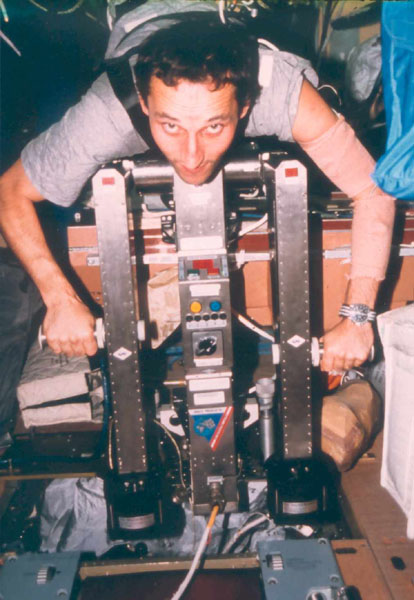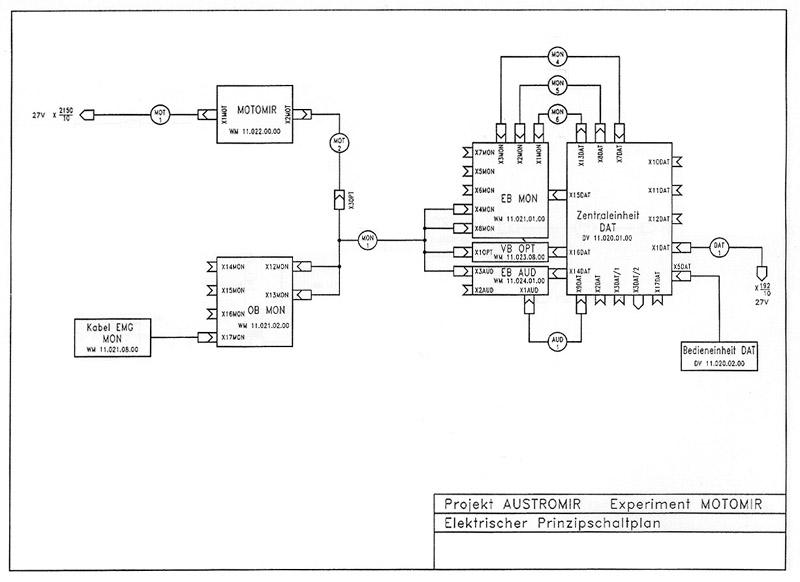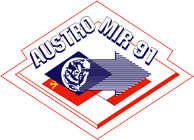Weightlessness does not only affect the heart circulation system, bone density and fluid balance, but also the musculature. Regular body training is the best method against degradation of the muscles. Regular training is the best method against amyotrophia. A lot of adequate experience on the length and type of the exercise is already available from previous flights (east and west).
The iso-kinetic method of operation starts to make exact examinations possible. These exceed experience. In the long-term, MOTOMIR served as a way to provide the effective training. For this reason standardized and reproducible training conditions were necessary, because only in this way exact scientific proof is possible.
Objectives
The results are not only used in space flights but mostly also in medicine. Weightlessness can be considered as an extreme provocation test, comparable with the Bed Rest Syndrome, which is being bed-ridden for a considerable amount of time due to injury or sickness. Various incidents, such as muscular atrophy and heart circulation system degradation appear quicker and more intense in weightlessness. To that affect, questions regarding therapy and rehabilitation can be quickly examined, shortening the restoration phase. Concrete concepts are still being planned.
Functionality, Measuring principle
The ergometer MOTOMIR is the training equipment of cosmonauts. Two actors (similar to pedals) can be adapted for leg work as well as for arm work. The cosmonaut sits on a titanium saddle and must move them in a defined way. He trains and applies pressure with the arms or the legs on the moving, motor-controlled actors. He can try to accelate or decelarte. Step-motors guarantee a constant speed. This is important, because the device is constructed as a thrust and drag ergometer for a specific movement pattern, that is, for an iso-kinetic one. This means that the angular velocity of the examined joint remains always constant, so that the muscle is burdened with a force proportional to each fiber length.
MOTOMIR should deliver new insights on the functionality of the arm and leg muscular structure in weightlessness and the weariness of the muscles under stress. It is for this reason that a special ergometer was developed to serve scientific purposes as well as for the cosmonautsí training.
Shared equipments of the Austrian payload
DATAMIR, MONIMIR
Results
In the experiment the changes of the strength and acceleration attributes of man in weightlessness was observed with greater exactness and in more detail.Diverging opinions regarding the affects of short-time flights on muscles cropped up short before the execution of the AUSTROMIR project. This was on the basis of ground tests carried out at the Institute for Biomedicinal Problems in Moscow within the last fifteen years. These tests suggested that movement strength and speed reduced to a hypo-kinetic status directly after the changeover into weightlessness. However one expected a smaller regression in weightlessness than in immersion.

The data won within the MOTOMIR framework proved this thesis. A tendential reduction of the maximum strength and strength length could already be noticed from the second flight-day. The changes were quite extensive on the fifth flight-day, whereby those muscles involved in the locomotion and upright posture were affected first. An analysis of the results showed that flexor strength was less affected than the extensor strength. It was noticed that the detraction of the muscular endurance and the respective regeneration required more time than the maximum muscular strength. In general, it was noted that a reduction of leg strength occurred in all analytical methods. The armís muscular endurance was also involved but no consistent pattern could be noted.
A comparison of isometric and dynamic strengths support the hypothesis that the reduction in strength is not connected to muscular atrophy but to a reduction of muscular tonicity. All muscle fibres were affected evenly resulting in a diffused change of muscular performance.
The data on hand deliver a good basis for the improvement of diagnostics on motor deficits and the development of effective training therapies.
Practical application
Application ranges
- Activity physiological basic research
- Sport medicine (diagnostics and training control)
- Rehabilitation and prevention
- Epidemiology
Application target
- Increase of effectiveness in the training in sport and in rehabilitation
- Appraisal of muscular ability
- Rehabilitation therapy after traumata and neurologial diseases
Direct interested institutions on the utilization of the experiment results
- Institute for Sport Sciences of the University Vienna, Branch Sport Physiology
- Institute for Biomedical Problems, Moscow
- Medical rehabilitation facilities in Austria and Germany
- NASA
- ESA
- Company NOVA, Vienna
- Company Ing. Bumba, Vienna
Technical characteristics
The equipment MOTOMIR consisted of the following units

Ergometer MOTOMIR including the equipment and reserve parts
- Ergometer MOTOMIR
- Cable MOT1
- Cable MOT2
- Breast backing for armwork
- Shoes with fixation for footwork
- Mechanical interface MOTOMIR – MIR
- Universal keys
- Transport casing
| Mass: | 48.0 kg |
| Dimensions: | 1050 mm x 485 mm x 420 mm |
| Power input: | max. 760 W 2200 W Impulse max. value |
Experimenters
Medicine:
o. Univ.-Prof. Dr. Norbert Bachl (project manager)
Mag. Harald Tschan
Dr. Ramon Baron
all: Institute for Sport Sciences, Branch Sport- and Earned Physiology, Vienna
Technics:
Dipl.-Ing. Dr. Massud Mossaheb (project manager)
Dr. Harald Stockhammer
all: FDP, Company Fanak Data Processing Ges.m.b.H., Vienna
Sub-contractor:
Ing. Walter Bumba
Ing. Christian Wieland
Ing. Michael Smutka
Ing. Werner Fuchs
all: Company Ing. Walter Bumba, Vienna
